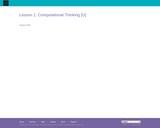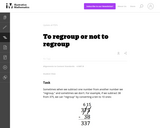
Students will review and practice breaking numbers apart into expanded form in order to add.
- Subject:
- Mathematics
- Material Type:
- Diagram/Illustration
- Learning Task
- Date Added:
- 06/20/2018

Students will review and practice breaking numbers apart into expanded form in order to add.

In this lesson, students will learn the steps involved in computational thinking. Decomposition, pattern matching, abstraction, and algorithms are all steps that make up the computational thinking process. This process is used in many learning subjects and in real-life learning. Learners discover how understanding each step can help them as a learner and also nurture a growth mindset.

This is an entire unit of activities relating to whole numbers, place value and rounding. The activity I use is called "Reality Checking" on pages 57-64. "Reality Checking" provides a real world connection for students to practice and apply the standard algorithm for addition and subtraction. Students will work either individually, with a partner or group to balance a mock checking account. Students will add whole number deposits and subtract whole number withdrawals while using estimation to check for reasonableness.

Okta challenges you to a duel! That crazy octopus wants to play you in a game where the first person to choose cards with a specified sum wins. You can choose how many cards, what types of numbers, and Okta's level of strategy.

In this 25-day module of Grade 4, students extend their work with whole numbers. They begin with large numbers using familiar units (hundreds and thousands) and develop their understanding of millions by building knowledge of the pattern of times ten in the base ten system on the place value chart (4.NBT.1). They recognize that each sequence of three digits is read as hundreds, tens, and ones followed by the naming of the corresponding base thousand unit (thousand, million, billion).
Find the rest of the EngageNY Mathematics resources at https://archive.org/details/engageny-mathematics.

(Nota: Esta es una traducción de un recurso educativo abierto creado por el Departamento de Educación del Estado de Nueva York (NYSED) como parte del proyecto "EngageNY" en 2013. Aunque el recurso real fue traducido por personas, la siguiente descripción se tradujo del inglés original usando Google Translate para ayudar a los usuarios potenciales a decidir si se adapta a sus necesidades y puede contener errores gramaticales o lingüísticos. La descripción original en inglés también se proporciona a continuación.)
En este módulo de 25 días de grado 4, los estudiantes extienden su trabajo con números enteros. Comienzan con grandes números utilizando unidades familiares (cientos y miles) y desarrollan su comprensión de millones al desarrollar el conocimiento del patrón de tiempos diez en el sistema Base Ten en la tabla de valor del lugar (4.nbt.1). Reconocen que cada secuencia de tres dígitos se lee como cientos, decenas y, seguidas de la denominación de la base correspondiente, mil unidad (mil, millones, mil millones).
Encuentre el resto de los recursos matemáticos de Engageny en https://archive.org/details/engageny-mathematics.
English Description:
In this 25-day module of Grade 4, students extend their work with whole numbers. They begin with large numbers using familiar units (hundreds and thousands) and develop their understanding of millions by building knowledge of the pattern of times ten in the base ten system on the place value chart (4.NBT.1). They recognize that each sequence of three digits is read as hundreds, tens, and ones followed by the naming of the corresponding base thousand unit (thousand, million, billion).
Find the rest of the EngageNY Mathematics resources at https://archive.org/details/engageny-mathematics.

Students will review and practice breaking numbers apart into expanded form in order to subtract.

This task presents an incomplete problem and asks students to choose numbers to subtract (subtrahends) so that the resulting problem requires different types of regrouping. This way students have to recognize the pattern and not just follow a memorized algorithm--in other words, they have to think about what happens in the subtraction process when we regroup. This task is appropriate to use after students have learned the standard US algorithm.